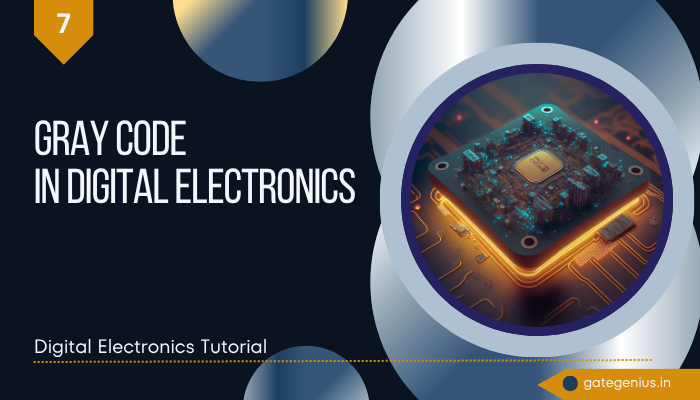Understanding Gray Code in Digital Electronics, it is essential to know how binary representations affect data processing in digital systems. While binary numbers are efficient, they can lead to errors during transitions when multiple bits change simultaneously. Gray Code in digital electronics, also known as Reflected Binary Code, solves this problem by ensuring that only one-bit changes at a time between successive numbers. This single-bit transition minimizes errors and enhances accuracy in systems like encoders, analog-to-digital converters, and digital communication systems.
This blog will explain what Gray Code is, how it works, its generation methods, advantages, disadvantages, and applications in digital electronics.
What is Gray Code?
Gray Code is a binary numeral system where two successive values differ in only one bit. This property is known as a unit distance code and is especially useful in preventing glitches or errors in digital circuits where the value transitions from one state to another.
Unlike traditional binary numbers where multiple bits may change between two numbers, Gray Code guarantees that only a single bit changes, reducing the chance of incorrect readings during state transitions.
Example:
Compare Decimal to Binary and Gray Code for first few values:
| Decimal | Binary | Gray Code |
|---|---|---|
| 0 | 0000 | 0000 |
| 1 | 0001 | 0001 |
| 2 | 0010 | 0011 |
| 3 | 0011 | 0010 |
| 4 | 0100 | 0110 |
| 5 | 0101 | 0111 |
| 6 | 0110 | 0101 |
| 7 | 0111 | 0100 |
Why Use Gray Code?
Gray Code in digital electronics is used primarily to minimize errors during binary transitions. In normal binary, multiple bits might change at once, causing intermediate incorrect values. However, Gray Code ensures only one bit flips, thus reducing the chance of misinterpretation, especially in sensitive systems like rotary encoders and ADCs.
It is highly useful in:
- Position sensors
- Error correction
- Digital communication systems
- Electromechanical devices
How to Convert Binary to Gray Code
To convert binary to Gray Code:
- The MSB (Most Significant Bit) of Gray Code is the same as the binary.
- Each subsequent Gray bit is found by XORing the current binary bit with the previous one.
Example: Convert Binary 1011 to Gray Code
Step 1: First bit = 1
Step 2: 1⊕0 = 1
Step 3: 0⊕1 = 1
Step 4: 1⊕1 = 0
→ Gray Code = 1110
How to Convert Gray Code to Binary
To convert Gray Code back to binary:
- The MSB remains the same.
- Each next binary bit is found by XORing the previous binary bit with the current Gray bit.
Example: Convert Gray Code 1110 to Binary
Step 1: First bit = 1
Step 2: 1⊕1 = 0
Step 3: 0⊕1 = 1
Step 4: 1⊕0 = 1
→ Binary = 1011
Types of Gray Code in Digital Electronics
Gray Code in digital electronics comes in various types, each tailored for specific use cases like counters, encoders, and memory systems. Below are some common types along with examples for better understanding.
1. Reflected Binary Gray Code (Standard)
The most widely used type is the Reflected Binary Gray Code, where only one bit changes between successive values. This minimizes the chance of errors during state transitions.
The Gray Code in digital electronics is designed to ensure smooth transitions between binary states. It also helps avoid glitches in digital circuits, making it ideal for analog-to-digital converters and rotary encoders.
Example:
Binary: 000, 001, 010, 011, 100, 101, 110, 111
Gray Code: 000, 001, 011, 010, 110, 111, 101, 100
Notice how only one bit changes between successive Gray Code values.
2. Binary-Reflected Gray Code for n-Bits
This type of Gray Code is created using a reflection and prefixing method. The (n−1)-bit Gray Code is written, then reflected, and prefixes of ‘0’ and ‘1’ are added to the original and reflected parts, respectively.
The Gray Code in digital electronics is alsos highly scalable and useful in designing logic circuits. It helps create sequences that are easy to implement and reliable for switching circuits.
Example for 3-bit Gray Code using reflection method:
Step 1: 2-bit Gray Code → 00, 01, 11, 10
Step 2: Reflect → 10, 11, 01, 00
Step 3: Add 0 to original and 1 to reflected → 000, 001, 011, 010, 110, 111, 101, 100
This results in an efficient and minimal-error sequence for hardware design.
3. Gray Code Counter
A Gray Code Counter is a sequential circuit that counts in Gray Code order instead of binary. This is extremely useful where only one bit change is desirable between states to avoid timing issues.
The Gray Code in digital electronics is alsos beneficial for counter-based systems like rotary encoders, digital meters, and memory read/write operations. These counters improve synchronization and reduce noise-related errors.
Example Sequence for a 3-bit Gray Code Counter:
000 → 001 → 011 → 010 → 110 → 111 → 101 → 100
This sequence ensures that only one bit changes at each step, reducing the risk of logic hazards.
Advantages of Gray Code in Digital Electronics
1. Only One Bit Changes at a Time
Gray code in digital electronics is designed so that only a single bit changes between two consecutive values. This property is highly beneficial in preventing large logic jumps during transitions, which is a common issue in binary counting. It ensures smooth and predictable behavior in circuits, especially where the precise order of states matters.
2. Prevents Errors During Transitions Between Values
In digital circuits, especially those involving physical movement or analog signals, fast transitions can introduce unwanted noise. Gray code in digital electronics helps reduce such transition errors because a single-bit change is less likely to cause glitches or misreads compared to multiple simultaneous bit changes in binary systems.
3. Minimizes Switching Errors
Switching multiple bits at once in binary can lead to incorrect outputs if all bits do not switch at the exact same moment. Gray code in digital electronics minimizes this by ensuring that only one bit switches, which is especially useful in mechanical systems such as rotary encoders, where contact bounce is common. It helps maintain signal accuracy even under imperfect switching conditions.
4. Useful in Error Detection
Since Gray code in digital electronics changes only one bit at a time, any transition that shows more than one bit change can be immediately flagged as an error. This makes Gray code an effective tool for detecting faults in digital communication or sensor systems, improving reliability in error-sensitive environments.
5. Simplifies Digital Circuit Design
Many modern sensors, especially those used in robotics and automation, output data in Gray code. Using Gray code in digital electronics reduces the need for additional conversion circuits, simplifying the design and improving overall efficiency. This makes Gray code a preferred choice in many industrial applications.
6. Efficient in Analog-to-Digital Conversion
Analog-to-Digital Converters (ADCs) often use Gray code in digital electronics to minimize errors during rapid signal changes. Since only one bit changes at a time, it significantly reduces the likelihood of erroneous readings that can occur due to bit-level misalignment during conversion.
7. Avoids Hazard Conditions
Gray code in digital electronics helps avoid hazards or race conditions in synchronous circuits. When multiple bits change at once, there’s a risk that some bits may transition before others, leading to temporary and incorrect states. Gray code eliminates this issue by ensuring controlled and sequential state transitions, making it safer for use in high-speed digital systems.
Disadvantages of Gray Code in Digital Electronics
1. Not Suitable for Arithmetic Operations
Gray code in digital electronics is not designed for direct arithmetic operations like addition or subtraction. Unlike binary numbers, Gray code does not follow a straightforward numeric progression, which makes performing calculations directly on Gray-coded values difficult and impractical. Therefore, arithmetic processing requires additional steps.
2. Requires Conversion to Binary for Processing
In most digital systems, data processing and arithmetic are performed in binary. Gray code in digital electronics must be converted back to binary before any meaningful calculations can take place. This conversion adds extra processing steps, which can increase the time and complexity of operations in digital circuits.
3. Conversion Circuits Needed
Using Gray code in digital electronics necessitates the inclusion of additional conversion circuits to translate between binary and Gray code formats. These extra logic components increase the overall circuit complexity, consume more hardware resources, and can add to the cost and power consumption of the system.
4. Not a Weighted Code
Gray code in digital electronics is a non-weighted code, meaning it lacks positional value weights like those found in binary or BCD codes. This makes it less intuitive for humans to understand and interpret directly, especially when compared to weighted codes where each bit has a defined numeric significance.
5. Limited Use Outside of Transition-Based Applications
Gray code in digital electronics is primarily useful in applications where minimizing errors during transitions between states is critical. Outside these scenarios, such as in general arithmetic or data storage, traditional binary code is preferred due to its simplicity and ease of use.
6. Harder to Read Manually
When manually reading or debugging digital data, binary code is easier for humans to interpret than Gray code. Gray code sequences do not correspond directly to familiar decimal values, which can make manual analysis and troubleshooting more challenging for engineers and technicians working with digital systems.
Applications of Gray Code
1. Rotary Encoders and Shaft Position Sensors
Gray code in digital electronics is widely used in rotary encoders and shaft position sensors to accurately read angular positions. Because only one bit changes at a time, Gray code prevents errors that can occur during the rotation of the shaft. This ensures smooth and reliable position tracking, which is critical in robotics, industrial automation, and motor control applications.
2. Analog-to-Digital Converters (ADCs)
Gray code in digital electronics is employed in analog-to-digital converters to help prevent glitches when signals change rapidly. During the conversion process, only one bit changes between consecutive values, reducing the possibility of incorrect readings caused by transient states. This leads to more accurate and stable digital output from analog inputs.
3. Error Detection in Digital Communications
In digital communication systems, Gray code in digital electronics helps ensure accuracy when transmitting sequential data over noisy channels. The property of changing only one bit at a time makes it easier to detect and correct errors during data transmission, improving overall communication reliability.
4. Digital Systems with Mechanical Input Devices
Gray code in digital electronics is used to reduce bounce and transition issues in digital systems that rely on mechanical input devices such as buttons and switches. Mechanical contacts often cause multiple unintended transitions, but Gray code’s single-bit change property minimizes glitches and ensures stable input readings.
5. Hardware State Machines
Gray code in digital electronics is utilized in hardware state machines to prevent asynchronous switching errors. By ensuring only one bit changes between states, Gray code helps avoid hazards and race conditions during state transitions, which improves the reliability of finite state machine operations in complex digital circuits.
6. Karnaugh Maps Simplification
Gray code in digital electronics is used to label Karnaugh maps (K-maps) because it ensures that adjacent cells differ by only one variable. This simplifies the process of minimizing Boolean expressions, making it easier for engineers and designers to optimize digital logic circuits efficiently.
Frequently Asked Questions?
Q1. What is the main advantage of Gray Code over Binary Code?
A1. Gray Code changes only one bit between successive values, reducing transition errors.
Q2. Is Gray Code a weighted code like BCD?
A2. No, Gray Code is not a weighted code. It’s a unit distance code.
Q3. Can we perform addition directly in Gray Code?
A3. No, Gray Code is not suitable for direct arithmetic operations. It must be converted to binary first.
Q4. Where is Gray Code most commonly used?
A4. In rotary encoders, ADCs, and digital sensors to avoid transition errors.
Q5. How is Gray Code different from binary in terms of bit change?
A5. Binary may change multiple bits at once; Gray Code changes only one bit between values.
Conclusion
Gray Code in Digital Electronics plays a crucial role in systems where error-free transitions are essential. Its ability to ensure only one bit changes at a time makes it highly reliable for mechanical sensors, rotary encoders, and analog-to-digital converters. Though not suitable for arithmetic or data storage efficiency, its importance in reducing glitches and simplifying hardware design cannot be understated.
As digital systems become more precise and error-sensitive, Gray Code continues to serve as a fundamental technique in ensuring data integrity during transitions.
I hope you understand the Gray Code in Digital Electronics. So don’t forget to share this post with friends and anyone preparing for the GATE, UGC NET exams, or studying at the university.



